Freeze-drying is an essential unit operation in manufac ture of injectable drug products, but the process suffers from being very ineffificient, with cycle times of days rather than a few hours, as in most pharmaceutical unit operations. The inherent ineffificiency of the process is commonly made worse by a trial-and-error approach to cycle development, where process conditions may be developed that are far from optimum, where optimum conditions are defifined as those that minimize cycle time while providing a pharmaceutically acceptable product using conditions that are within the capability of the equipment.
Identifification of optimum conditions for primary drying has been facilitated in recent years by application of a graphical design space for primary drying (1,2). A represen tative design space is illustrated in Fig.1, with sublimation rate on they-axis and chamber pressure on thex-axis. There are two sets of isotherms—one for shelf temperature and one for product temperature. The design space is constructed usingfifirst principles of heat and mass transfer along with measured values for the vial heat transfer coeffificient (Kv) and the resistance of the dried product layer toflflow of water vapor during primary drying (Rp). These isotherms establish the relationship between the process variables that are directly controlled, shelf temperature and chamber pressure, and product temperature, a critical process variable that is not directly controlled.
















